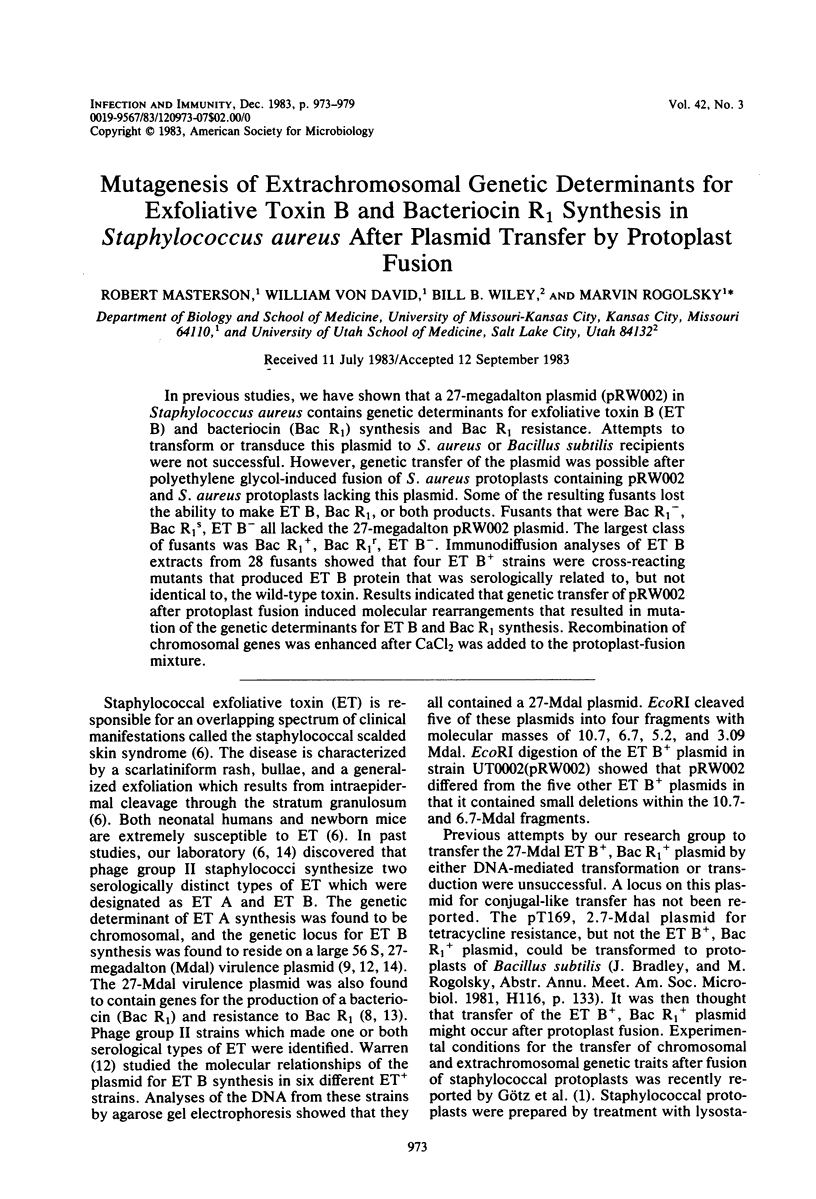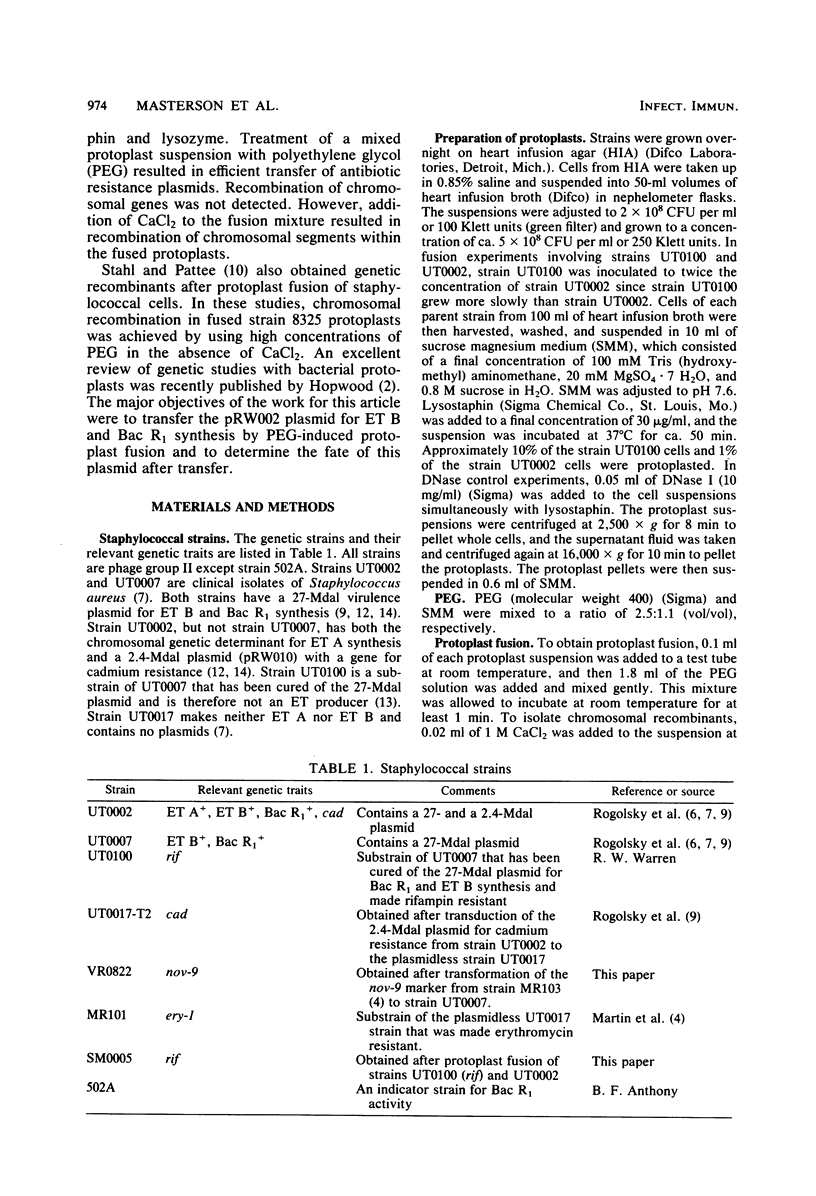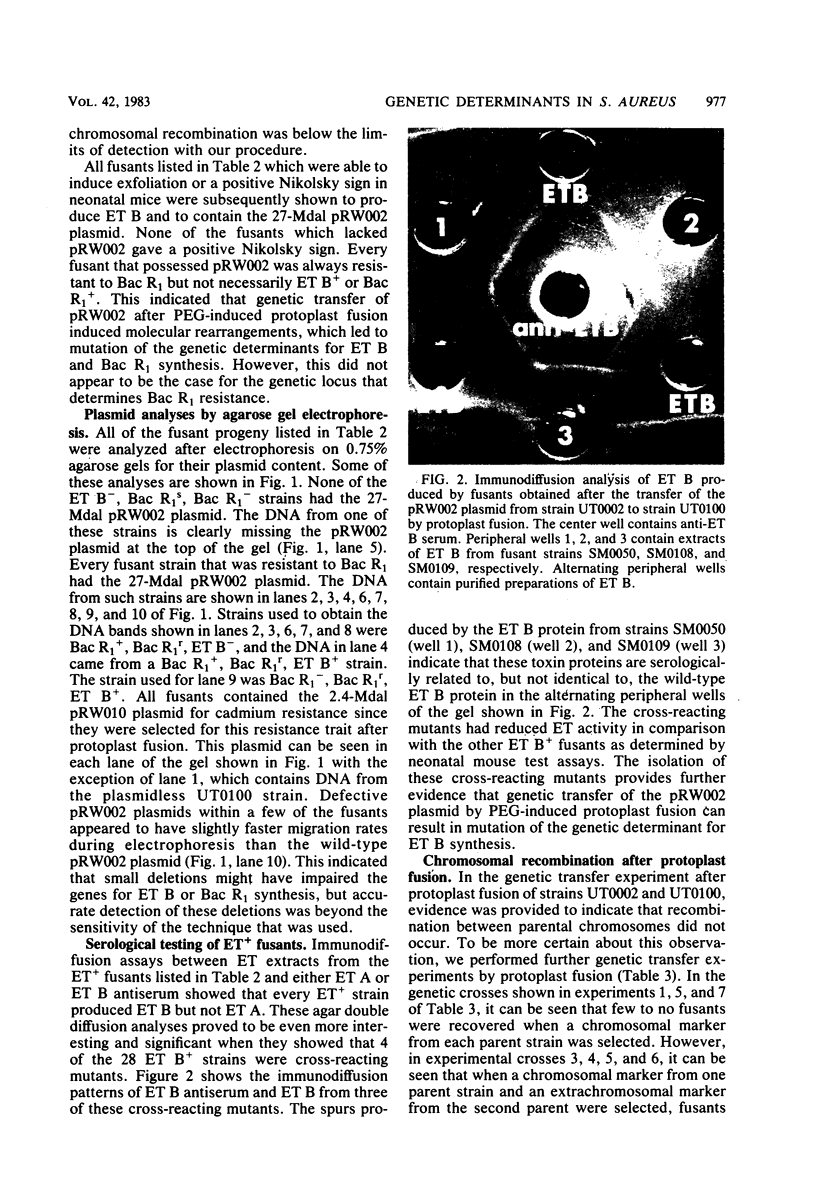Abstract
In previous studies, we have shown that a 27-megadalton plasmid (pRW002) in Staphylococcus aureus contains genetic determinants for exfoliative toxin B (ET B) and bacteriocin (Bac R1) synthesis and Bac R1 resistance. Attempts to transform or transduce this plasmid to S. aureus or Bacillus subtilis recipients were not successful. However, genetic transfer of the plasmid was possible after polyethylene glycol-induced fusion of S. aureus protoplasts containing pRW002 and S. aureus protoplasts lacking this plasmid. Some of the resulting fusants lost the ability to make ET B, Bac R1, or both products. Fusants that were Bac R1-, Bac R1s, ET B- all lacked the 27-megadalton pRW002 plasmid. The largest class of fusants was Bac R1+, Bac R1r, ET B-. Immunodiffusion analyses of ET B extracts from 28 fusants showed that four ET B+ strains were cross-reacting mutants that produced ET B protein that was serologically related to, but not identical to, the wild-type toxin. Results indicated that genetic transfer of pRW002 after protoplast fusion induced molecular rearrangements that resulted in mutation of the genetic determinants for ET B and Bac R1 synthesis. Recombination of chromosomal genes was enhanced after CaCl2 was added to the protoplast-fusion mixture.
Full text
PDF






Images in this article
Selected References
These references are in PubMed. This may not be the complete list of references from this article.
- Götz F., Ahrné S., Lindberg M. Plasmid transfer and genetic recombination by protoplast fusion in staphylococci. J Bacteriol. 1981 Jan;145(1):74–81. doi: 10.1128/jb.145.1.74-81.1981. [DOI] [PMC free article] [PubMed] [Google Scholar]
- Hopwood D. A. Genetic studies with bacterial protoplasts. Annu Rev Microbiol. 1981;35:237–272. doi: 10.1146/annurev.mi.35.100181.001321. [DOI] [PubMed] [Google Scholar]
- Jackson M. P., DeSena J., Lednicky J., McPherson B., Haile R., Garrison R. G., Rogolsky M. Isolation and characterization of a bacteriophage factor that confers competence for genetic transformation to an exfoliative toxin-producing strain of Staphylococcus aureus. Infect Immun. 1983 Feb;39(2):939–947. doi: 10.1128/iai.39.2.939-947.1983. [DOI] [PMC free article] [PubMed] [Google Scholar]
- Martin S. M., Shoham S. C., Alsup M., Rogolsky M. Genetic mapping in phage group 2 Staphylococcus aureus. Infect Immun. 1980 Feb;27(2):532–541. doi: 10.1128/iai.27.2.532-541.1980. [DOI] [PMC free article] [PubMed] [Google Scholar]
- McDonnell R. W., Sweeney H. M., Cohen S. Conjugational transfer of gentamicin resistance plasmids intra- and interspecifically in Staphylococcus aureus and Staphylococcus epidermidis. Antimicrob Agents Chemother. 1983 Jan;23(1):151–160. doi: 10.1128/aac.23.1.151. [DOI] [PMC free article] [PubMed] [Google Scholar]
- Rogolsky M. Nonenteric toxins of Staphylococcus aureus. Microbiol Rev. 1979 Sep;43(3):320–360. doi: 10.1128/mr.43.3.320-360.1979. [DOI] [PMC free article] [PubMed] [Google Scholar]
- Rogolsky M., Warren R., Wiley B. B., Nakamura H. T., Glasgow L. A. Nature of the genetic determinant controlling exfoliative toxin production in Staphylococcus aureus. J Bacteriol. 1974 Jan;117(1):157–165. doi: 10.1128/jb.117.1.157-165.1974. [DOI] [PMC free article] [PubMed] [Google Scholar]
- Rogolsky M., Wiley B. B., Glasgow L. A. Phage group II staphylococcal strains with chromosomal and extrachromosomal genes for exfoliative toxin production. Infect Immun. 1976 Jan;13(1):44–52. doi: 10.1128/iai.13.1.44-52.1976. [DOI] [PMC free article] [PubMed] [Google Scholar]
- Rogolsky M., Wiley B. B. Production and properties of a staphylococcin genetically controlled by the staphylococcal plasmid for exfoliative toxin synthesis. Infect Immun. 1977 Mar;15(3):726–732. doi: 10.1128/iai.15.3.726-732.1977. [DOI] [PMC free article] [PubMed] [Google Scholar]
- Stahl M. L., Pattee P. A. Computer-assisted chromosome mapping by protoplast fusion in Staphylococcus aureus. J Bacteriol. 1983 Apr;154(1):395–405. doi: 10.1128/jb.154.1.395-405.1983. [DOI] [PMC free article] [PubMed] [Google Scholar]
- Thompson N. E., Pattee P. A. Genetic transformation in Staphylococcus aureus: demonstration of a competence-conferring factor of bacteriophage origin in bacteriophage 80 alpha lysates. J Bacteriol. 1981 Oct;148(1):294–300. doi: 10.1128/jb.148.1.294-300.1981. [DOI] [PMC free article] [PubMed] [Google Scholar]
- Warren R. L. Exfoliative toxin plasmids of bacteriophage group 2 Staphylococcus aureus: sequence homology. Infect Immun. 1980 Nov;30(2):601–606. doi: 10.1128/iai.30.2.601-606.1980. [DOI] [PMC free article] [PubMed] [Google Scholar]
- Warren R., Rogolsky M., Wiley B. B., Glasgow L. A. Isolation of extrachromosomal deoxyribonucleic acid for exfoliative toxin production from phage group II Staphylococcus aureus. J Bacteriol. 1975 Apr;122(1):99–105. doi: 10.1128/jb.122.1.99-105.1975. [DOI] [PMC free article] [PubMed] [Google Scholar]
- Wiley B. B., Rogolsky M. Molecular and serological differentiation of staphylococcal exfoliative toxin synthesized under chromosomal and plasmid control. Infect Immun. 1977 Nov;18(2):487–494. doi: 10.1128/iai.18.2.487-494.1977. [DOI] [PMC free article] [PubMed] [Google Scholar]




